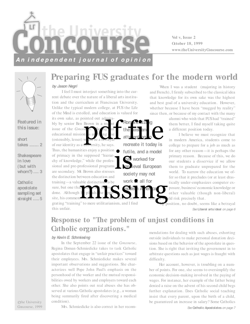Grasping at Receptivity
by the PhenTom of Franciscan University
Congratulations on Elizabeth Magaletta’s piece on “masculinism” which is at once powerful and ambiguous. Its strengths are obvious, its weakness a bit more difficult to deal with. Still, risking the charge of “masculinizing,” i.e., the “appropriation and pretended intellectual mastery of [the mystery of two sexes]” I would like to draw attention to what seems a weakness in the piece, a weakness which also seems to give Miss Magaletta’s argument a persuasive power. And the weakness is very simply a dismissal of the very mystery that she invokes in her closing lines.
In discussing equality Ms. Magaletta notes something that is in principle always possible, namely, the abandoning of reality “in favor of abstractions which ultimately become caricatures of reality.” If I understand her correctly, feminine receptivity is just such an abstraction which abandons the whole range of human personality. Feminine receptivity, she writes, is “obviously enough, an insight drawn directly from the realm of genital sexuality.” Had Ms. Magaletta noted that this is either an implicit or explicit premise operative in what she labeled “masculinism,” we would have had a real contribution to the critique of “masculinism”: it is certainly the case that the “male standpoint” is often represented by a perception of woman from the perspective of genital sexuality and it is as certainly wrong to do so. And she is right in rejecting such an understanding as a paradigm for understanding the difference between the sexes.
However, it also appears to be her own judgment that “feminine receptivity” is an insight drawn directly from the realm of genital sexuality. She then notes that, whatever the mystery of the difference of the sexes, it cannot be genital sexuality. This is obvious. But is it really also obvious that “feminine receptivity” is an insight directly drawn from genital sexuality? It seems that we have here a case similar to the derivation of monogamy from biological facts, assumed as fact in a previous article in the Concourse. If so, then receptivity as well as monogamy are not so much insights as simply synonyms for the respective biological facts. Because of this her argument acquires a certain strength. For it is, indeed, ridiculous to argue, as the masculinist is supposed to do, that her femininity, i.e., her genital sexuality, is a valid reason why a woman should not aspire to this or that profession but should, rather, stay home.
Having in effect dismissed feminine receptivity as something grounded in genital sexuality, Ms. Magaletta has tacitly accepted the premise of her “masculinist” opponent. So also, many feminists have reduced the difference between masculine and feminine to a matter of sexual genitality only to mimic the masculine in their bid for equality. It is not surprising that bitterness and rancor so often creep into their rhetoric against the “masculine” which they have been trapped into accepting as their own but which they cannot as easily reduce to genital sexuality as they did their own feminine receptivity. Feminism in turn often becomes as aggressive as the “masculinism” it mimics.
How obviously is female genital sexuality as such, or even from the perspective of the feminine, a matter of receptivity? Why wouldn’t it rather be a matter of “grasping” or “clutching” or “snatching” or “devouring”? One could presumably argue that the very notion of the “grasping female” is also an insight directly derived from female genital sexuality. Sartre, for one, perceived the reality of earth and nature, the metaphor for the feminine, as a dark, gaping maw that threatens to devour.
Why could it not be the other way around, if only to raise the question theoretically? In other words, why could it not be said that genital sexuality is directly derived from the respective “models” of femininity and masculinity as spiritual, not genital, traits of the human person? From such a perspective could one not, in the spirit of equality, also talk about the persistence of “feminism” as well as of “masculinism” at Franciscan University?
St. Paul asks us what have we that we have not received… why then do we act as if we have not received? Receptivity is a spiritual act that is “typical” of every human being in so far as he or she is a creature. But whether or not we, women and men, actually perform the act of receiving depends on us, not on our nature. But at the same time, receptivity can be considered, even if only paradigmatically, as a specific spiritual structure of femininity.
Women, to be sure, are as capable of giving as men are. But at issue is not the sphere of acts, but the spiritual structure of the feminine and masculine personalities. The failure to see this “spiritual structure” is in major part due, one may argue, not so much to “masculinism” or “feminism” but rather to a rejection of the vocation of every created person who is called to make a “sincere gift of self to others.” The central theme of the culture of death is a focus on “appropriating” and a rejection of “giving.” The new liturgical word of this culture is “Mine,” whereas the only true and effective liturgical word is the “Thine” uttered by Christ.
The mystery of the difference between the masculine and the feminine, and the affirmation of this mystery, cannot be discussed in terms of equal access to the neutral, or rather, neutered professions. If these are the norm for and the meaning of social roles, then it is consistent to be as indignant as is Miss Magaletta at the attempt to “dictate social roles” on the basis of “feminine receptivity,” read as “genital sexuality.” Contemporary feminist rhetoric makes much of the professions, understood in purely sociological, not truly social terms, because they provide an opportunity for self-realization. Thus, mere genital sexuality should not bar access to the “social roles” of lawyer, engineer, soldier or whatnot, since these are the opportunities for realizing one’s personal potential. On such an account, motherhood and “domesticity” simply become one of the alternative fields for self-realization. Such a view contradicts the Christian vision in which the person is called, i.e., has a vocation, to respond to others rather than to simply realize his or her own potential.
In my considered opinion, it is futile to discuss or attempt to clarify the difference between femininity and masculinity as spiritual structures of the person unless one first recognizes the basic vocation of man(!) to respond to a transcendent other, to neighbor and ultimately to God. This means that only against the background of the vocation to respond to Christ with the “total gift of self” can we again recapture the mystery of femininity and masculinity which will express themselves of their own accord in the proper response to Christ in Himself and in our neighbor. To invoke and paraphrase Gaudium et Spes #24, we will find (discover) ourselves as feminine and masculine only in the sincere gift of self to others. Failing to do this, we will be drawn along by the culture of death as it reduces femininity and masculinity to genital sexuality, with the consequence of ourselves perverting, i.e. caricaturing, our own femininity and masculinity. With this culture, we will inadvertently offer to our young women the Harpy, as the “feminine” ideal of the grasping claw, and to our young men the Slob, as the “masculine” ideal of the one who lets it all hang out. No wonder that the contemporary “wimp factor” needs women as reinforcement in desert sands.
The true model for femininity is Our Lady in her receptivity to the Word of God. She too is the Mother teaching her boys to be men with the exhortation to “do whatever He tells you.” And He, for His part, felt no need to announce his “male” superiority. He considered it enough to have given His life for His Bride. And She, to have received Him. What a glorious honor to the Woman to have His divine majesty crowned by her receptivity!
The author prefers to remain anonymous.


